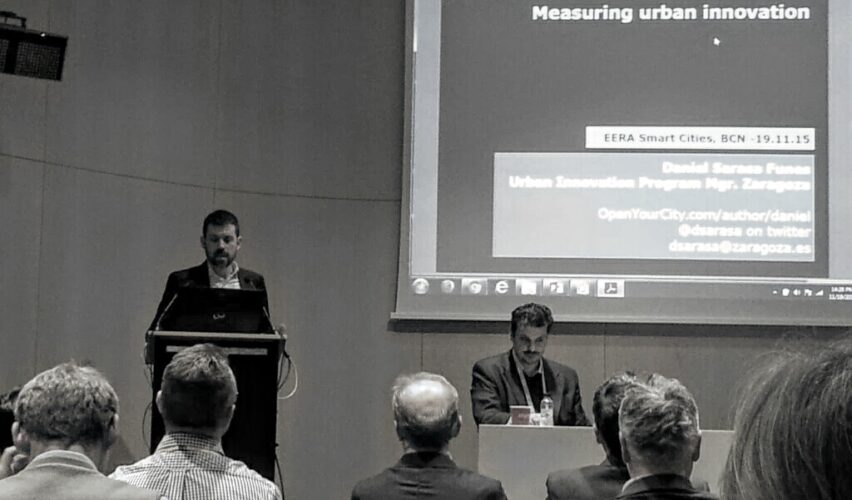On 19th, November 2015, we spoke at the Smart City Expo in Barcelona about the slippery subject of applying KPIs to measure urban innovation.
Somebody said: “What can’t be measured, probably does not exist”. He or she was probably an engineer, like most of our audience. But take for instance love and wrath, hunger or joy, selfishness or cooperation. Those concepts do exist, are as real as us, humans, and they will probably escape from the engineers’ measurement capabilities still for a long time.
When dealing with public policies, we are interested in understanding what drives greenness, prosperity, or democracy. The answer in many fields is: cities. But cities can only support that burden if they innovate at a higher pace everytime, what makes cities to find themselves trapped in what we call the innovation spiral: the ability of cities to accelerate the production of ideas that tackle the challenges above.
Our job in Zaragoza (Spain) is to design appropriate public policies, hopefully innovative, about urban innovation. Our particular innovation cycle goes like this: observe, read, think, plan, design, implement, cultivate, measure,… and share. So, even us that sometimes dream with becoming a social scientist, can not escape from the engineer’s fate: what can’t be measured, it does not exist.
So, let’s face it: we still need some KPIs. Here is how we think they could look like:
- A KPI is not just an indicator, it is a Key Performance Indicator. Keys open doors, as answers do. Before taking out another KPI, think about the importance of the question that your KPI will unveil.
- This one is for the cities: be smart and define what performance means for you yourself. Don’t let others do the thinking. In the Citykeys project cities actively participate in a collaborative discussion about how indicators will help policy makers.
- Listen to the lean start-up movement and escape from the vanity metrics temptation. If you measure quantity over quality, you’ll find it difficult to understand key processes such as civic engagement, nurturing local talent, or collaborative city making.
- Simplicity and meaningfulness often come together. A KPI that already exists but that fairly encompasses what the engineer wants might be better than a brand new, perfect KPI, that very few people understand.
- And, with simplicity and meaning, citizen engagement is at an arm’s reach. Zaragoza City Hall sends the individual water consumption to every home every month along with a message of congratulations or warning. This is part of a wide succesful program to reduce water needs in the city.
We gave the audience some practical examples of KPIs for urban innovation projects. CIEM Zaragoza start-up incubator is an interesting initiative because it addresses environmental, employment and innovation issues transversally. The story of its conception, design and exploitation showcases many of the wonderful subtleties and contradictions that we’d face if we blindly applied KPIs to decision making or to shaping public policies.
This and other similar experiences lead naturally to a final remark: don’t expect that your KPI’s will impose full rationality in urban decision making. Cities are fortunately much more complex than that. Decision making in cities need rationality, but also some arbitriarity and politics. Besides, decision makers need to deal with an increasing degree of uncertainty. Data driven government might be a nice futuristic dream, but today’s government has more to do with being wise and quick to grasp opportunities as they present than with rigid long-term planning.
This article is published under a Creative Commons license. Some rights reserved.















